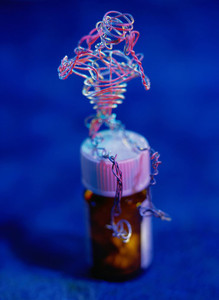Generic immediate-release carbamazepine tablets are AB-rated generic versions of Novartis’s Tegratol. In this market, Taro is the leading supplier with half the market. Teva Pharmaceutical Industries Ltd follows with more than a quarter of the market, and Sun’s Caraco is the third-leading supplier with a share of about 18%. The only other supplier currently in the market is Apotex.
Generic chewable carbamazepine tablets are a chewable form of the anticonvulsant that carry the same label and indications as the immediate-release tablets. They are prescribed in the same way as the immediate-release products, but come in a more convenient dosing form, which makes them better suited for paediatric, geriatric, and other patients who may have difficulty swallowing pills.
With a market share of 65%, Teva was the leading seller of the generic chewable carbamazepine tablets in 2007, followed by Taro with a share of about 31% and Sun, with a share of only 4% in 2007. Cadista, the only other approved supplier of generic chewable carbamazepine tablets, is not supplying the product currently. Sun and Taro are the only companies that have applied for FDA approval of generic versions of Novartis’s Tegretol-XR extended-release carbamazapine tablets. This extended-release formulation of the drug is indicated for the same uses as the immediate release products, but offers the added convenience of a less-frequent-dosing regimen.
In this highly competitive carbamazepine tablets market, research papers are often (mis)cited by leading players to prove whether or not clinically relevant toxicity differences exist between the various carbamazepine preparations.
One of such papers is that by Tothfalusi, Speidl and Endrenyi, who published a study in the British Journal of Clinical Pharmacology of May 2007, in which an exposure-response analysis would reveal that clinically important toxicity differences may exist between bioequivalent carbamazepine tablets.
In their article ‘generalised additive modelling (GAM)’ is used, which is a nonparametric ‘model-free’ procedure for developing statistical models and considered to be a useful, but mostly exploratory, graphical technique. In one way, GAM is more flexible than the standard logistical model, but it also forces more restrictions on the structure. In particular, it requires additivity of the terms and cannot incorporate interactions between factors. Random (mixed-effect) logistic regression was used to model the relationship between adverse effects, concentration and time. The fitted model is a generalised linear mixed-effect (also called random-logistic) model in its original domain. Assuming that all random effects were zero, a sigmoidal pharmacokinetic/pharmacodynamic (PK/PD) model for tolerance was obtained and a direct relationship between the PK parameters, like the absorption rate constant, and the probabilities (or risks) of adverse events, was also obtained.
Generally accepted PD metrics do not exist at present, but based on the simplicity and easily interpreted properties they selected Rmax, which is the maximum risk (probability) of having an adverse effect at some time during the observation period, a close analogue of Cmax. Consequently, the ratio between the test (T) and reference (R) formulations (RmaxT/RmaxR) is a measure of relative risk due to generic switching.
They found that a tolerance model could reasonably describe the concentration and time dependence of adverse effects. A mixed-effect tolerance model was fitted to the data in order to check statistically the adequacy of the model and to estimate the PD model parameters. As a first step of the model building, they checked whether a simplified form, where some of the terms were omitted, could still yield a statistically satisfactory fit. The answer was negative – all factors needed to be included in the model. The full model provided a reasonably good fit for dizziness, but a not particularly good fit for drowsiness. However, the overall adverse events (ABH) were predicted quite well. The prediction, based upon assuming zero random effects, corresponds to a volunteer with ‘average’ responsiveness. However, the participants in the study were very different in their toleration of carbamazepine, because the between-subject variation of responsiveness was highly significant. They estimated parameters for ABH with their CIs, after which an estimate of EC50 = 2.29 mg/L could be obtained (the initial sensitivity that exponentially increases with time).
It was assumed that the four formulations differed from each other only in their absorption rates, but had common CL/F and Vd values. The ka values were set to the estimated rate constants of Products A, B, C and D, respectively. while Vd and CL/F were those of Product D. Setting the parameters in this way, it was possible to focus only on the effect of absorption rates and eliminate the effects of the other kinetic parameters. This way they obtained considerable differences among estimated toxicities, the peak risk (Rmax) of the fastest-absorbing formulation being about twice as high as that of the slowest one. They recalculated the results relative to the reference formulation D and obtained a serious sensitivity problem in the Rmax ratios (0.69, 1.23 and 1.46).
They concluded that using a combination of modern exploratory data analysis (GAM) with mixed-effect PK/PD modelling, a highly significant relationship was shown using the results of a relatively small, conventional size BE trial previously performed by Mr Martin Olling from the Dutch Medicines Evaluation Board (MEB-CBG). However, such a highly hypothetical model cannot be used as scientific evidence.
The authors claimed that the therapeutic risk of switching (the Rmax ratio) is strongly underestimated by ratios of Cmax and, to a lesser extent, of partial AUC. Therefore the use of AUCP, while not ideal, is much preferable to indicate rate-related toxicity. It is acceptable to the FDA even if it has not been widely applied. According to them, their results suggested that more consideration should be give to using AUCP for the evaluation of bioequivalence of narrow therapeutic index drugs.
References:
ANALYSIS OF AGREEMENT CONTAINING CONSENT ORDERS TO AID PUBLIC COMMENT In the Matter of Sun Pharmaceutical Industries Ltd., FTC File No. 071-0193.
Laszlo Tothfalusi, Szilvia Speidl, Laszlo Endrenyi. Exposure-response analysis reveals that clinically important toxicity difference can exist between bioequivalent carbamazepine tablets. Br J Clin Pharmacol. January 2008;65(1):110-22.
Olling M, Mensinga TT, Barends DM, Groen C, Lake OA, Meulenbelt J. Bioavailability of carbamazepine from four different products and the occurrence of side effects. Biopharm Drug Dispos. 1999;20:19-28.
Source: Federal Trade Commission; British Journal of Clinical Pharmacology; Biopharmaceutics & Drug Disposition








 0
0











Post your comment